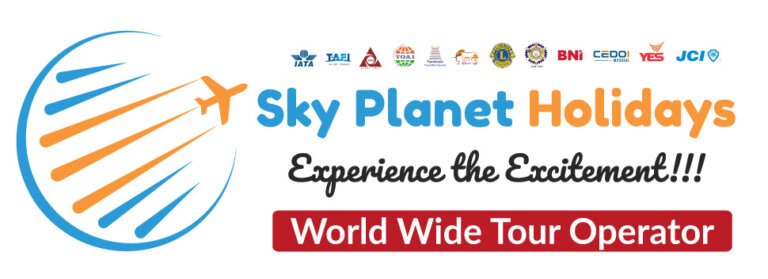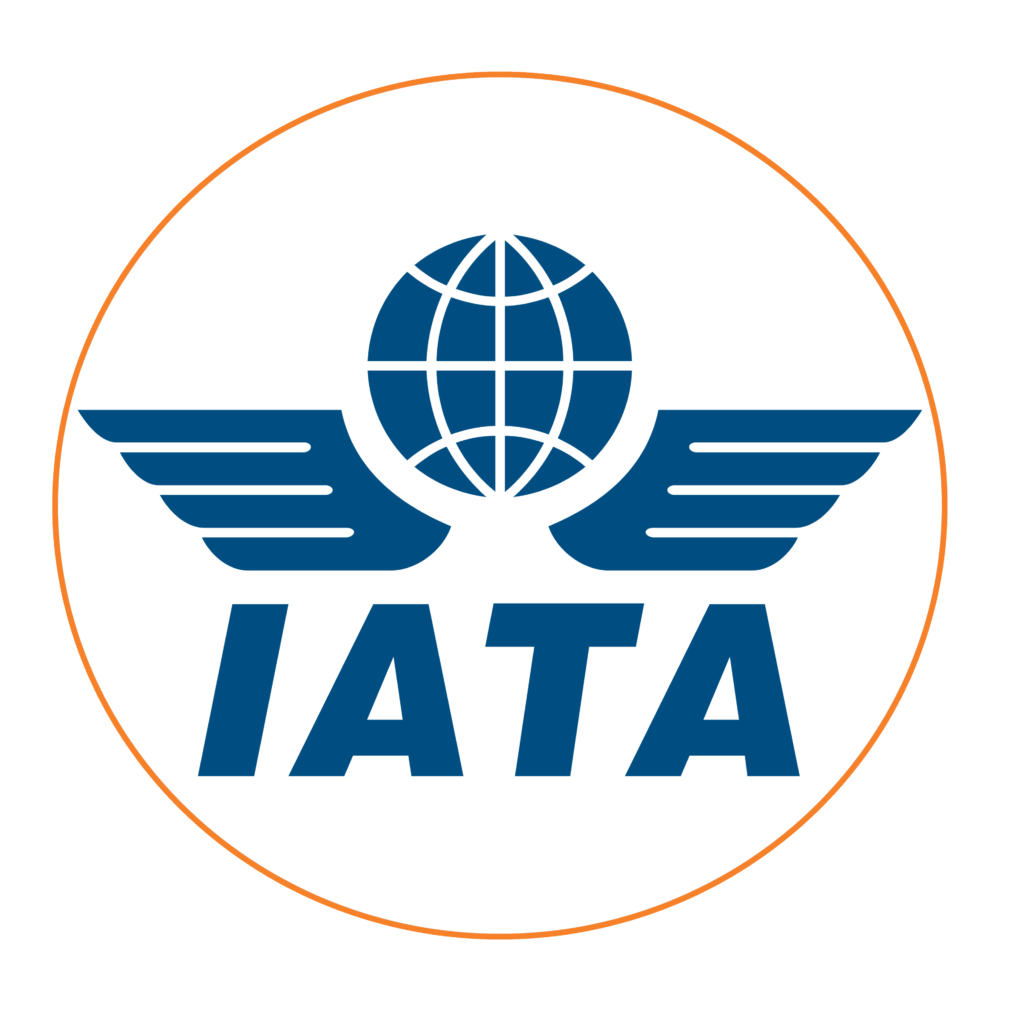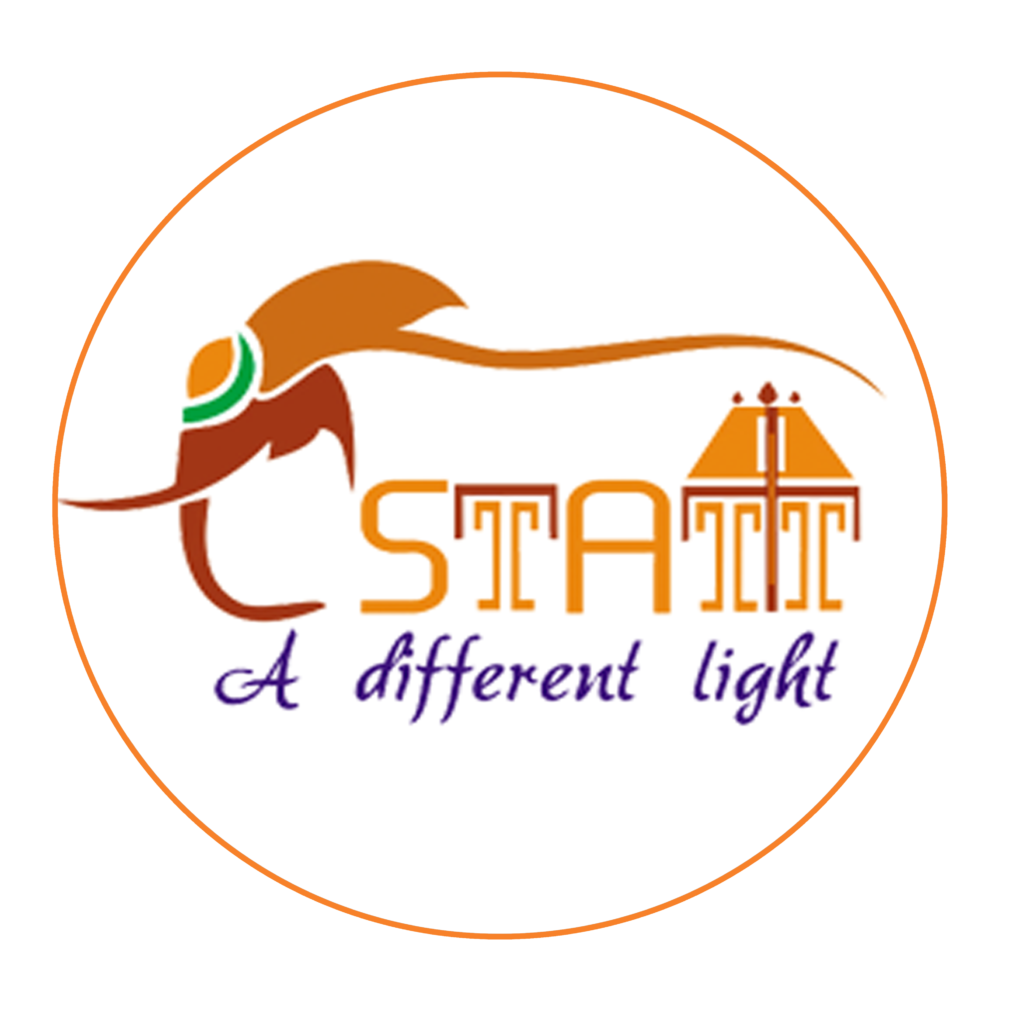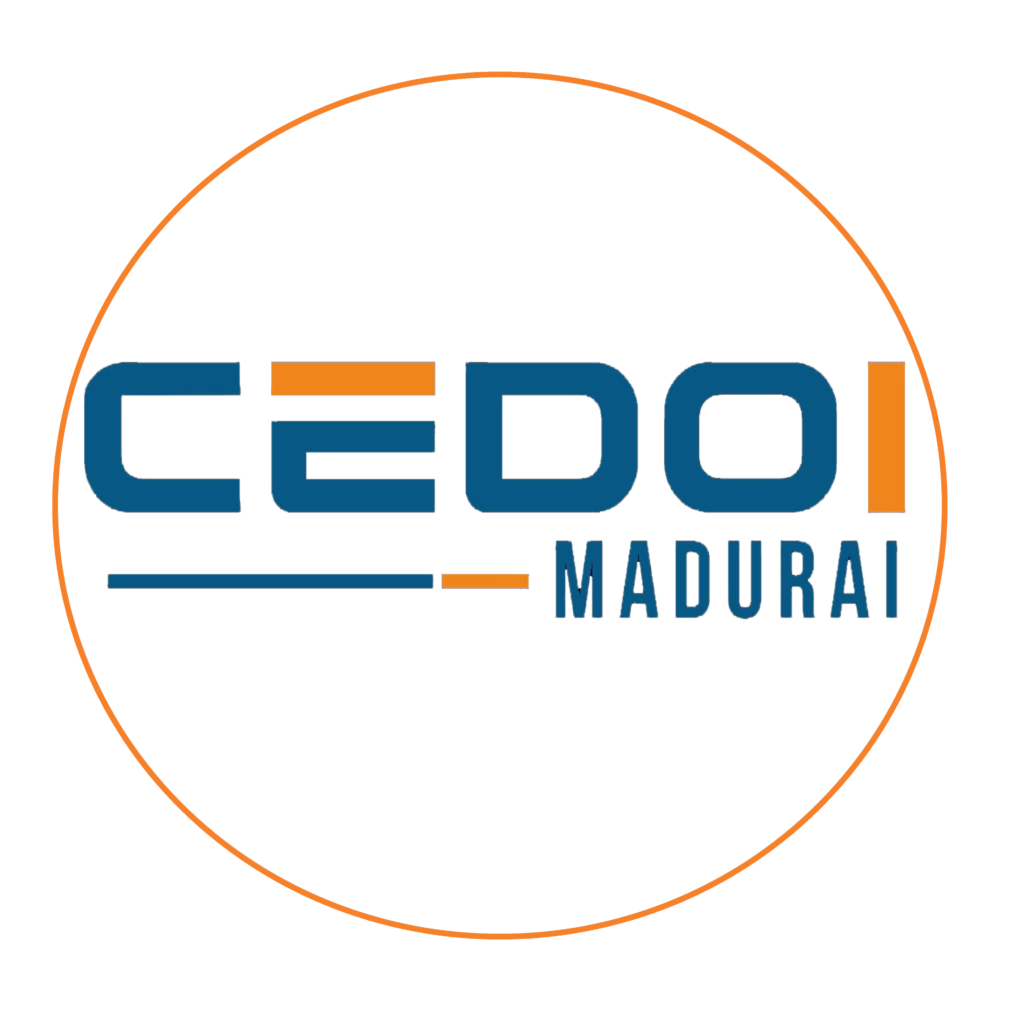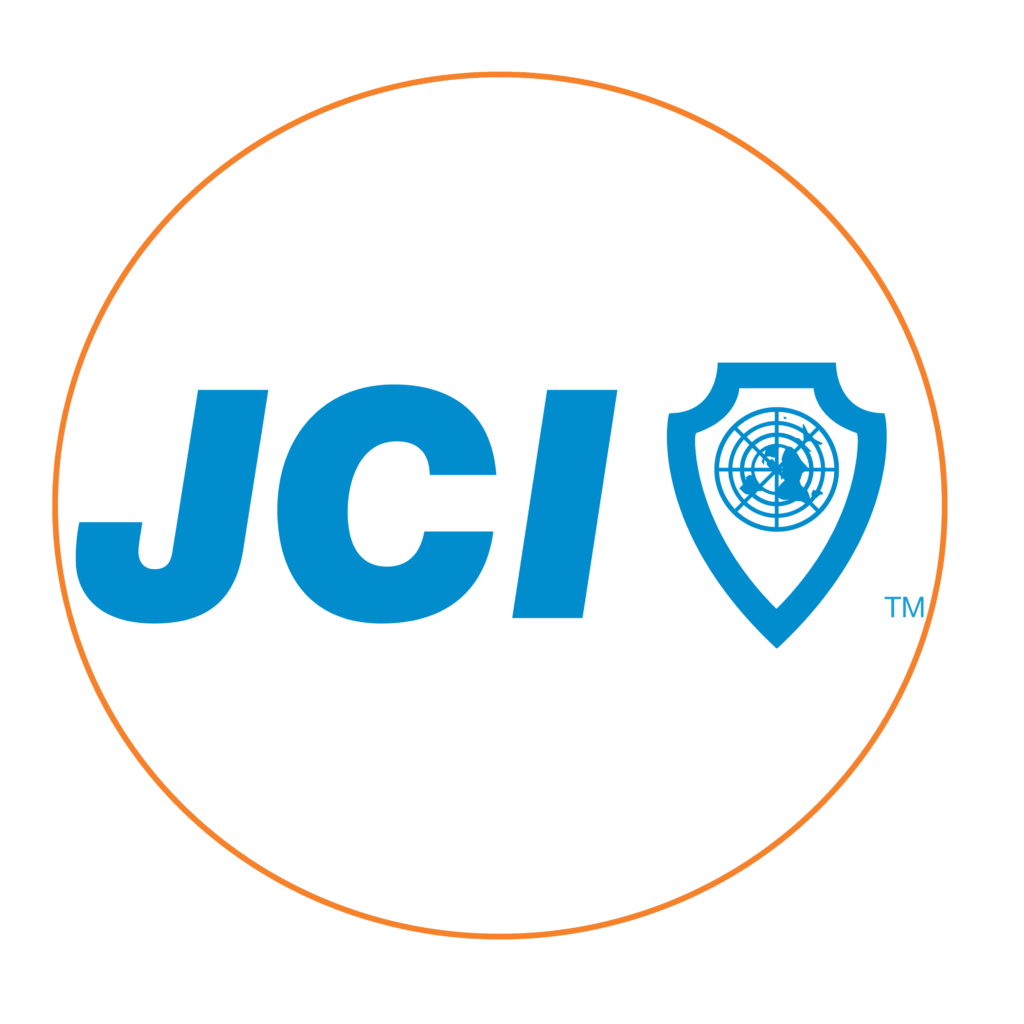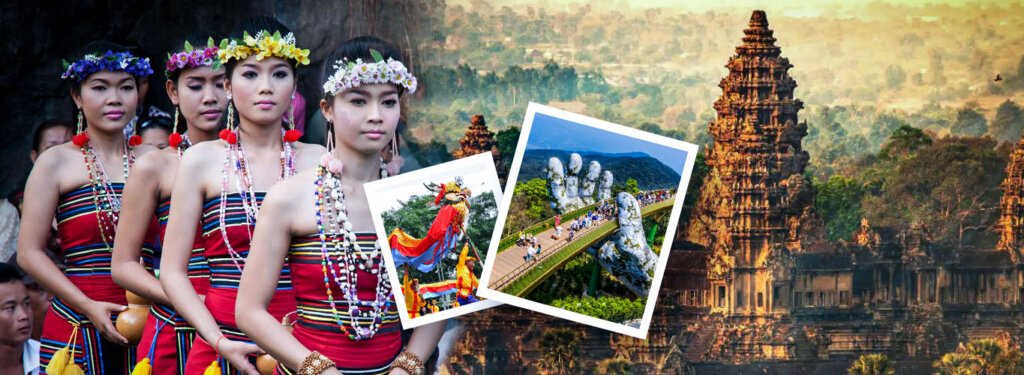
South India's No. 1 Travel Agency ✨
💱 Currency
Vietnamese Dong (VND) in Vietnam
Cambodian Riel (KHR) in Cambodia; US Dollars widely accepted
🗣️ Languages
Vietnamese (official in Vietnam)
Khmer (official in Cambodia); English widely spoken in tourist areas
🌤️ Climate
22°C – 35°C
📅 Best Season to Visit
November to March (Cooler temperatures, dry weather, ideal for sightseeing and cultural exploration)
🛡 Quick Travel Tips for Vietnam & Cambodia
- 🏧 ATMs are easy to find in cities and tourist areas—notify your bank before traveling to prevent card issues.
- 💳 Credit/debit cards are accepted in hotels, upscale restaurants, and major shops. Cash is preferred in rural areas and local markets.
- 🏦 Banks: Open Mon–Fri, 8:00 AM–4:30 PM. Currency exchange is available at airports, hotels, and licensed money changers.
- 🍷 Legal drinking age is 18 in both countries. You may be asked for ID in bars or clubs.
- 🤝 Cultural etiquette: Respectful behavior is valued. A slight bow or nod is common. Dress modestly when visiting temples.
- 💰 Low to moderate cost. Tipping is not mandatory but appreciated—especially in restaurants, hotels, and for guides or drivers (5–10%).
What Are Vietnam and Cambodia Famous For? – A Quick Introduction
Vietnam is renowned for its dramatic landscapes, which include lush rice terraces cascading down emerald-green hillsides, striking limestone karsts rising majestically from serene waters, and vibrant cities like Hanoi and Ho Chi Minh City buzzing with motorbikes, coffee shops, and colonial charm. The country also draws attention for its war history, including iconic sites like the Cu Chi Tunnels and War Remnants Museum, as well as its well-preserved French colonial architecture seen in buildings, cathedrals, and tree-lined boulevards. Culinary lovers are especially drawn to Vietnam’s irresistible street food culture, offering world-famous dishes like pho, banh mi, and fresh spring rolls served right on the sidewalks.
Renowned for its magnificent temple complexes, Cambodia’s crown jewel is Angkor Wat, the largest religious monument globally and a symbol of national heritage. Beyond the grandeur of Angkor, Cambodia captivates visitors with its serene countryside dotted with rice fields and sugar palm trees, floating villages that drift across the Tonlé Sap Lake, and a resilient spirit born from a complex history. The timeless allure and authenticity of Vietnam and Cambodia continue to mesmerize travellers.From ancient ruins and UNESCO World Heritage Sites to scenic coastlines and iconic cruises like Halong Bay and the Mekong River, these destinations offer a rich mosaic of experiences. Lively local markets brim with color and character, showcasing handcrafted goods, local spices, and traditional garments. For those planning a combined itinerary, Vietnam Cambodia tour packages offer a convenient and cost-effective way to explore both countries in a single journey. Beyond sightseeing, both nations provide a deeper connection through their captivating mix of customs, festivals, daily rituals, and centuries-old arts, making them perfect for cultural explorers, history buffs, and first-time international travellers alike.
Vietnam and Cambodia Tour Packages
Most Chosen Vietnam and Cambodia Plans by Our Happy Customers
How Are India and Vietnam–Cambodia Connected? – Cultural & Historical Ties
India shares a long-standing cultural connection with both Vietnam and Cambodia that extends back to ancient times. Hinduism and Buddhism, which originated in India, significantly influenced Cambodian culture.Originally built as a Hindu temple honoring Lord Vishnu, the world-renowned Angkor Wat eventually transformed into a Buddhist place of worship. In Vietnam, Indian influence can be observed in the ancient Champa Kingdoms of Central Vietnam, particularly in the My Son temple complex which features Hindu deities and South Indian architectural elements.
Modern diplomatic relations between India and these Southeast Asian countries have grown stronger over the years, with vibrant trade partnerships, collaborative tourism initiatives, and educational exchanges. Direct flights from Indian cities and the convenience of e-visa facilities have made these countries more accessible than ever for Indian travellers.
Culturally, Indian music, festivals, Bollywood movies, and cuisine have gained popularity in both countries, especially in urban areas. Indian embassies actively participate in promoting cultural programs and heritage exchanges, further strengthening the historical bond between these nations.
Interesting Things to Know About Vietnam & Cambodia Before You Go
The official currency in Vietnam is the Vietnamese Dong (VND), while Cambodia uses the Cambodian Riel (KHR); however, US dollars are widely accepted in Cambodia, particularly in tourist-friendly regions, and often used in hotels, restaurants, and transport. In Vietnam, it’s advisable to carry smaller denominations of Dong for local markets and street vendors, as change in foreign currency is not always available. Credit and debit cards are widely accepted in larger cities and hotel chains across both countries, but carrying some cash is essential, especially in rural areas or when shopping at small stalls.Vietnamese and Khmer are the official languages of their respective countries. While these languages are predominant in daily life, English is commonly spoken in most tourist hotspots, hotels, and restaurants, making communication manageable for Indian visitors. In major cities like Hanoi, Ho Chi Minh City, Siem Reap, and Phnom Penh, tour guides and hotel staff often speak basic English, and signage in English is also quite common.
When visiting religious sites, temples, or pagodas, travellers are expected to dress modestly by covering their shoulders and knees. Footwear should be removed before entering sacred areas. Carrying a lightweight scarf or shawl is a good idea, especially when sightseeing in hot weather. It’s also respectful to keep your voice low and avoid pointing at religious statues or monks.While tipping is not mandatory, it is always appreciated and considered a kind gesture. Small tips for drivers, guides, and restaurant servers go a long way and are often expected in more tourist-oriented establishments. Tipping amounts can be modest—around 5 to 10% of the bill or a small cash token of appreciation.
What to Know Before Booking a Vietnam–Cambodia Tour Package
Combining Vietnam and Cambodia in one travel itinerary offers a more enriching experience and is a popular choice for Indian tourists. It’s wise to understand some basics before booking your trip. Indian passport holders can conveniently apply for e-visas to both countries. For itineraries that involve exiting and returning, a multi-entry visa is recommended. A trip of at least 10 to 14 days is recommended to properly explore key attractions. A classic route typically includes Hanoi, Halong Bay, Hoi An, Ho Chi Minh City, and then crosses over to Cambodia to visit Siem Reap and the capital Phnom Penh. There are direct flights available from India to Hanoi and Ho Chi Minh City, and short domestic flights or overland bus rides connect Vietnam to Cambodia efficiently.
In terms of weather, it’s best to avoid the monsoon season that runs from May to October. The most pleasant time for sightseeing and outdoor activities is from November to March.
Which Are the Best Budget Vietnam–Cambodia Tour Packages?
Indian travellers looking for affordable yet immersive experiences will find several attractive tour packages tailored to various budgets and interests. The “Vietnam & Cambodia Explorer” is a 10-day package starting at around ₹85,000 and covers must-visit destinations such as Hanoi, Halong Bay, and the world-famous Angkor Wat. A more extensive option, “Highlights of Indochina,” spans 14 days and includes highlights like Hoi An, the Mekong Delta, and Siem Reap, starting at approximately ₹1,20,000. For those with limited time, the “Essential Vietnam-Cambodia” package is ideal for shorter holidays, lasting 8 days and covering Ho Chi Minh City, Phnom Penh, and key temple complexes, with a starting price of ₹70,000.
To make the most of your journey, it’s recommended to select a Vietnam Cambodia tour plan that includes comfortable accommodation, internal transport, meals, and guided sightseeing. Look for travel agencies that offer Indian-friendly hotels, customizable itineraries, and meal preferences that suit vegetarian or Indian diets. With the right plan, exploring the historical wonders and scenic beauty of both countries becomes convenient, culturally enriching, and incredibly memorable.
Quick Facts About Vietnam & Cambodia – Geography, Wildlife & People
Vietnam stretches along a long coastal strip and features a diverse topography that includes mountains in the north and west. It is home to many unique and endangered species such as pangolins, langurs, and a variety of birds. The population comprises 54 ethnic groups, with the majority being Kinh people.
Cambodia, in contrast, is largely composed of flat plains interspersed with rivers and lakes like the Mekong River and Tonlé Sap Lake. Its wildlife includes elephants, gibbons, and rare species such as the Bengal florican. The Khmer people form over 90 percent of the population and have maintained rich cultural traditions that reflect their Hindu-Buddhist roots.
Vietnam Cambodia Tour Packages
| High Season |
November to March: Cool & dry (best time) April to June: Hot, fewer crowds |
|---|---|
| Iconic Attractions |
Vietnam: Halong Bay, Hoi An, Cu Chi Tunnels, Hanoi Old Quarter Cambodia: Angkor Wat, Bayon Temple, Tonlé Sap, Royal Palace |
| Popular Activities | Halong Bay cruises, temple tours, floating villages, Mekong Delta trips, cooking classes, cycling, night markets |
| Visa | E-visa available for Indian citizens; check border-crossing rules |
| National Animal |
Vietnam: Water Buffalo Cambodia: Kouprey |
| National Flower |
Vietnam: Lotus Cambodia: Rumdul |
| Famous Food |
Vietnam: Pho, Banh Mi, Bun Cha, Spring Rolls Cambodia: Amok Trey, Nom Banh Chok, Khmer Curry, Lok Lak |
Top 10 Reasons Why Tourists Love Visiting Vietnam & Cambodia
Travellers are drawn to Vietnam and Cambodia for many reasons. Angkor Wat in Cambodia ranks among the most awe-inspiring temple complexes globally. Meanwhile, Vietnam’s Halong Bay enchants travellers with its stunning limestone formations and tranquil cruises. The cultural richness of both nations shines through in traditions like Cambodia’s graceful Apsara dance and Vietnam’s timeless Ao Dai. Their culinary scenes are equally exciting, offering iconic dishes like Vietnamese Pho, Banh Mi, and Cambodian Amok. Luxury here is highly affordable, with four-star hotels and spa treatments costing a fraction of what they do in India. Tourists are also impressed by the warm hospitality of locals who often greet visitors with genuine friendliness.
Both countries are steeped in history, from the Cu Chi Tunnels in Vietnam to the Killing Fields in Cambodia. The natural beauty is undeniable, with rice terraces, coastal beaches, and tropical forests providing unforgettable experiences. Finally, local markets and spiritual sites add to the charm, offering a chance to shop for crafts and witness age-old religious practices.
When Is the Best Time to Visit Vietnam & Cambodia?
Vietnam and Cambodia experience three main seasons, each offering a unique travel experience depending on your interests. The dry season, which lasts from November to March, is widely considered the best time to visit. During this period, the weather is cooler, humidity is lower, and skies are generally clear—ideal conditions for sightseeing, beach trips, boat cruises, and outdoor adventures. It’s also the peak tourist season, especially around Christmas, New Year, and the Lunar New Year (Tet), so booking accommodations and tours in advance is highly recommended.
The hot season, from April to May, brings higher temperatures and a more intense sun, but also comes with some advantages. Tourist attractions are less crowded, and hotels often offer discounts or attractive deals. This period is ideal for budget-conscious travellers or those who prefer quieter experiences. Light cotton clothing, sunblock, and hydration are musts if you’re planning to explore cities or temples during these warmer months.
The rainy season, which runs from June to October, sees short but frequent showers, especially in the afternoons. While travel can be a bit trickier due to wet conditions, the landscape during this season is absolutely breathtaking—lush, green, and vibrant. This is also a great time for photographers and nature lovers to capture the countryside at its most beautiful. Popular spots like Halong Bay, the Mekong Delta, and Angkor Wat are less crowded, giving you a more intimate and peaceful experience. River cruises are particularly scenic during this time, with higher water levels enhancing access to remote villages and floating markets.
What Are the Best Things to Do in Vietnam & Cambodia?
In Vietnam, a cruise through the emerald waters of Halong Bay is a must. Exploring the vibrant Old Quarter of Hanoi gives insight into local life, while a lantern-lit evening stroll in Hoi An offers a magical atmosphere. History lovers will enjoy a visit to the Cu Chi Tunnels, while the wide boulevards and French architecture in Ho Chi Minh City make for charming walks.
In Cambodia, watching the sunrise over Angkor Wat is a spiritual experience. Cruise through Tonlé Sap Lake to discover floating villages and diverse natural habitats. Marvel at the Royal Palace in Phnom Penh, a stunning display of Khmer design. In Mondulkiri, connect with nature at ethical elephant sanctuaries. Wrap up your journey with a mesmerizing Apsara dance performance—a true taste of Cambodia’s cultural soul.
What Food Is Vietnam & Cambodia Known For? – A Guide to Regional Cuisine
Vietnamese cuisine is light, fresh, and full of herbs, with a delicate balance of sweet, sour, salty, and spicy flavors that reflect the country’s diverse geography and cultural heritage. Pho, the iconic noodle soup often made with beef or chicken, is a staple breakfast dish and a symbol of national pride. Banh Mi, a French-inspired baguette sandwich, is filled with a fusion of pickled vegetables, chili, cilantro, and various meats or tofu, making it a quick and satisfying street food favorite. Goi Cuon, or fresh spring rolls, are served cold with rice paper wraps, herbs, vermicelli noodles, and shrimp or pork, typically accompanied by a savory dipping sauce. Ca Kho To, a caramelized fish dish slow-cooked in clay pots with pepper, garlic, and fish sauce, offers rich, comforting flavors.
Regional Vietnamese cuisine also varies widely—from the spicy dishes of Central Vietnam to the sweeter tastes found in the south. In cities like Hoi An, you can try Cao Lau, a unique noodle dish made with smoky broth and crispy pork. In the Mekong Delta, dishes often feature coconut milk, river fish, and tropical fruits, reflecting the area’s abundant produce and water-based lifestyle.
Cambodian food is equally distinctive and shaped by ancient Khmer traditions, local ingredients, and seasonal produce. Considered the heart of Cambodian cuisine, Amok Trey is a rich and creamy fish curry infused with coconut milk and kroeung paste, then delicately steamed in banana leaves. For a lighter start to the day, locals savor Nom Banh Chok—a fragrant noodle soup topped with fresh cucumber, banana flower, and green curry broth.
A beloved choice for both locals and tourists, Lok Lak features stir-fried beef served with crisp greens, sliced tomato, and a tangy pepper-lime dip.Prahok, a fermented fish paste, is often used in cooking as a salty flavor enhancer and is considered an acquired taste central to Khmer cooking.
For vegetarians and those with dietary restrictions, both countries offer plenty of options. Many Buddhist communities in Vietnam and Cambodia observe vegetarian days, leading to a rich tradition of meat-free cuisine. You’ll find plenty of vegetarian delights like tofu dishes, stir-fried morning glory, tangy tamarind vegetables, and vibrant fruit salads featuring mango or green papaya. In tourist-friendly areas, especially in cities like Hanoi, Ho Chi Minh City, Siem Reap, and Phnom Penh, you’ll also find vegetarian restaurants and cafes that cater to Indian travellers with chapati-style breads, dal-style soups, and spice-friendly meals.
Food is an integral part of the experience offered by most Vietnam Cambodia tour packages, allowing travellers to savor authentic flavors, participate in cooking classes, and explore bustling food markets as part of their itinerary. For Indian tourists, these culinary adventures provide not just nourishment, but also a meaningful cultural connection with the local way of life.
Vietnam Cambodia Tour Destinations
| Hanoi | Hoan Kiem Lake, Old Quarter, Water Puppet Theatre, Temple of Literature, French Colonial Architecture, Street Food, Night Market |
|---|---|
| Halong Bay | Scenic Cruises, Limestone Karsts, Floating Villages, Caves & Grottos, Kayaking, UNESCO World Heritage Site |
| Hoi An | Ancient Town, Lantern-lit Streets, Tailor Shops, Riverside Cafés, Japanese Bridge, Traditional Markets, Bicycle Tours |
| Siem Reap | Angkor Wat, Bayon Temple, Ta Prohm, Apsara Dance Shows, Pub Street, Night Market, Khmer Street Food |
| Phnom Penh | Royal Palace, Silver Pagoda, Tuol Sleng Genocide Museum, Riverside Promenade, Russian Market, French Colonial Buildings |
| Tonlé Sap Lake | Floating Villages, Boat Tours, Bird Sanctuaries, Wetland Ecosystems |
| Kampot & Kep | Pepper Plantations, Riverside Cafés, Colonial-Era Towns, Crab Markets |
What Should Indian Travellers Know Before Visiting Vietnam & Cambodia?
Indian visitors should follow local etiquette, such as removing shoes before entering temples and using both hands when giving or receiving something. It’s a sign of respect in both cultures. While Vietnamese Dong is the currency in Vietnam, US dollars are widely accepted in Cambodia. You’ll find ATMs throughout the cities, and international cards are commonly accepted at hotels and large shops.Having a translation app or a phrasebook can be very helpful, especially in rural or offbeat locations.It’s a good idea to pack a small first-aid kit for unexpected situations. Stick to bottled water and eat at recommended restaurants to avoid foodborne illnesses. With a little preparation, your journey through Vietnam and Cambodia will be smooth, enriching, and unforgettable.
Where to Shop in Vietnam & Cambodia – Best Markets & Souvenirs
In Vietnam, Ben Thanh Market in Ho Chi Minh City offers a wide selection of clothes, souvenirs, and bags. At Hanoi’s night market, you’ll find a vibrant mix of handmade crafts, delicious snacks, and street shows. Hoi An stands out for its expert tailors who bring your custom designs to life.Some popular souvenirs from Vietnam include lacquerware, Vietnamese drip coffee sets, Ao Dai (traditional dress), and hand-crafted bamboo products.
Cambodia’s Angkor Night Market in Siem Reap is perfect for picking up local arts and textiles, while Phnom Penh’s Russian Market features antiques and silk scarves. Cambodian souvenirs range from Krama scarves and silver jewelry to intricately carved wooden items and palm sugar blocks.
How Is the Art and Culture Scene in Vietnam & Cambodia?
Both Vietnam and Cambodia possess rich and expressive cultural traditions that reflect their deep-rooted histories and spiritual foundations. In Cambodia, the Apsara Dance stands out as a cultural treasure—a graceful form of classical Khmer ballet inspired by celestial dancers from Hindu mythology. Performed in elaborate silk costumes and golden headpieces, the dance is not only visually stunning but also symbolically rich, telling stories of gods, nature, and ancient legends through slow, delicate hand movements and gestures. Performances are commonly held in Siem Reap, making them a must-see for cultural travellers.
In Vietnam, the Water Puppet Theatre is a must-see cultural experience. Originating over a thousand years ago in the Red River Delta, this unique art form was born from the flooded rice fields where villagers entertained one another with wooden puppets dancing atop water. Today, these shows are performed in theatres in Hanoi and Ho Chi Minh City, often accompanied by live traditional music using instruments like the dan bau, a one-stringed zither.
Vietnamese visual and folk arts are equally compelling. The country is renowned for calligraphy, ceramics, silk painting, and lacquerware, many of which reflect spiritual and historical themes. Travellers can explore art galleries, folk museums, and craft villages in destinations like Hanoi, Hue, and Hoi An, where traditional artists continue to preserve these meaningful cultural expressions.
For those seeking a culturally immersive journey, a well-curated Vietnam Cambodia tour plan ensures a balanced experience of ancient art forms, modern performances, and hands-on cultural engagement—making every day of your trip both meaningful and memorable.
